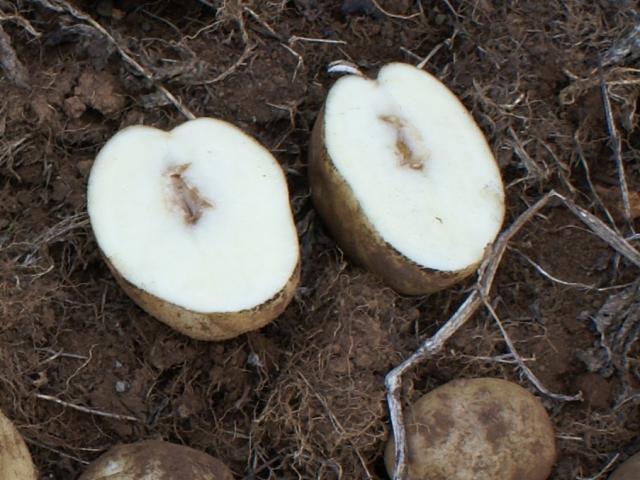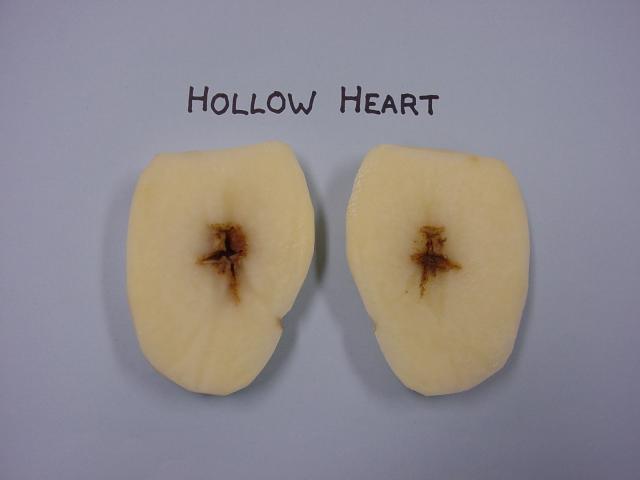Introduction
Hollow heart is an internal disorder where a 'lens' or 'star'-shaped cavity forms in the tuber. It appears to be caused by an abrupt change in tuber growth rate which usually occurs after a period of stress. Water, heat stress and associated calcium deficiency appear to have a role in the development of hollow heart.
The crisp variety Atlantic and the French fry variety Russet Burbank are prone to hollow heart but if conditions are right most varieties can be affected.
Hollow heart is an important problem for the potato industry as payments from processors and washer-packers for fresh market potatoes may be reduced.
Control
Hollow heart can be minimised by maintaining a constant and uniform growing environment.
The three main management factors which should be considered are:
- irrigation management to maintain uniform soil moisture
- crop management so high quality seed is planted at the appropriate spacing
- fertiliser management to ensure the crop is in nutrient balance.
Manage irrigation efficiently
Calibrate irrigation equipment at the start of the season. A properly calibrated irrigation system ensures that water is applied accurately, the watering pattern is even and the irrigation equipment runs efficiently.
Monitor soil moisture content using equipment such as tensiometers or TDR (time domain reflectometry) probes.The use of tensiometers is described in Scheduling irrigation using tensiometers on light/medium to heavy soils. Correct use of soil moisture monitoring equipment will help optimise irrigation and prevent over- or under-irrigation.
Select high quality seed
Full and rapid crop emergence from good quality seed ensures there are few gaps and misses in the crop from seed breakdown or poor germination. This means there is less chance of hollow heart developing in over-size tubers in patchy areas of the crop.
Buy seed from reliable suppliers approved by WA Seed Potato Producers Inc (contact Secretary Kate Wescott on westcottmechanical@bigpond.com for the seed grower list) to ensure good sanitary and physiological quality.
Follow best practice procedures for cutting seed to avoid contamination of seed pieces which can lead to breakdown of seed after planting.
Correct fertiliser management
Provide a properly balanced fertiliser program to avoid deficiency or toxicity of the essential macro and micro-nutrients. Management of nitrogen (N) and calcium (Ca) is particularly important.
Splitting nitrogen application can help achieve uniform growth. Instead of applying all 300kg N/ha before planting, on loamy soils apply one-third at planting and two-thirds after planting in two or three applications before row closure. On coastal sands, apply more than 75% of the nitrogen after planting in even weekly doses until just before early senescence.
Calcium deficiency appears to be associated with hollow heart, especially where there are brown areas or dead cells in the tuber. While calcium supply to the plant depends on water movement through the plant, and therefore irrigation management and climatic conditions, fertiliser supply can also be important.
It is important to have an adequate supply of calcium in the soil at planting. Gypsum applied at 1.2t/ha before planting is a good source of calcium in basal applications.
The more soluble versions of calcium, such as calcium nitrate at 300-400kg/ha applied after crop emergence, are more effective at minimising tuber disorders such as hollow heart than higher applications of less soluble forms before planting.
The rate of nitrogen applied in other fertilisers can be reduced by the amount supplied in calcium nitrate (45 to 60kg N/ha) which contains 15% nitrogen.
Magnesium sulphate (Epsom salts, 10% magnesium) at 200-300kg/ha should provide adequate magnesium for most crops.
Use petiole analysis to monitor nutrient levels. The first petiole sample should be collected when the largest tuber is 10mm long. Two or three other samples collected fortnightly will allow you to see whether the fertiliser application matches the crop’s requirements. This information should be used to improve the balance of nutrients in future crops.
Acknowledgement
The original version of this material was authored by Robert Money.


